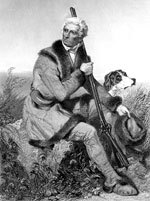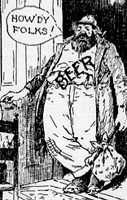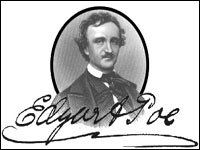Benjamin Franklin
Author Walter Isaacson discusses the life of Benjamin Franklin and his many contributions to the prosperity of colonial Philadelphia and his place in American history.
The feature may not appear on the first page.
Author Walter Isaacson discusses the life of Benjamin Franklin and his many contributions to the prosperity of colonial Philadelphia and his place in American history.
The feature may not appear on the first page.
Eighth-grade American history educator Eric Langhorst describes the "Book Blitz," an activity he uses to encourage students to explore the historical fiction novels available in their school library.
To listen to this "how to" podcast, scroll down to the blog archive links along the right hand side of the site. From there select "2009" and "January." Now scroll down to the end of the Friday, January 09, 2009 entry; and push play.
In this Library of Congress presentation, the children of author and civil rights activist M. Carl Holman—Kinshasha Holman-Conwill, Kwasi Holman, and Kwame Holman—reflect on the character of their father, who also served as the director of the National Urban Coalition.

Bringing together a wealth of material from libraries, archives, and museums, this website examines the history and culture of the state of Georgia. Legal materials include more than 17,000 state government documents from 1994 to the present, updated daily, and a complete set of Acts and Resolutions from 1799 to 1995. "Southeastern Native American Documents" provides approximately 2,000 letters, legal documents, military orders, financial papers, and archaeological images from 17301842. Materials from the Civil War era include a soldier's diary and two collections of letters.
The site provides a collection of 80 full-text, word-searchable versions of books from the early 19th century to the 1920s and three historic newspapers. There are approximately 2,500 political cartoons from 1946-1982; Jimmy Carter's diaries; photographs of African Americans from Augusta during the late 19th century; and 1,500 architectural and landscape photographs from the 1940s to the 1980s.

These historical materials come from 15 Kentucky colleges, universities, libraries, and historical societies. There are nearly 8,000 photographs; 95 full-text books, manuscripts, and journals from 1784 to 1971; 94 oral histories; 78 issues of Mountain Life and Work from 1925-62; and 22 issues of Works Progress Administration in Kentucky: Narrative Reports.
Photographs include collections by Russell Lee, who documented health conditions resulting from coal industry practices; Roy Stryker, head of the New Deal Farm Security Administration photographic section; and others that provide images of cities, towns, schools, camps, and disappearing cultures. Oral histories address Supreme Court Justice Stanley F. Reed, Senator John Sherman Cooper, the Frontier Nursing Service, veterans, fiddlers, and the transition from farming to an industrial economy. Texts include Civil War diaries, religious tracts, speeches, correspondence, and scrapbooks. Documents cover a range of topics, including colonization societies, civil rights, education, railroads, feuding, the Kentucky Derby, Daniel Boone, and a personal recollection of Abraham Lincoln.

This small, but useful, website offers a wide range of primary source material for researching the history of the prohibition movement, temperance, and alcoholism. The more than 1,800 items include broadsides, sheet music, pamphlets, and government publications related to the temperance movement and prohibition.
Materials come from the period leading up to prohibition, such as an 1830s broadside on the "Absent Father" as well as the prohibition era itself, such as a 1920 pamphlet entitled, "Alcohol Sides with Germ Enemies." They end with the passage of the 21st Amendment in 1933.
All digitized items are in the public domain. An essay, "Temperance and Prohibition Era Propaganda: A Study in Rhetoric" by Leah Rae Berk provides an overview of the topic and historical context.
The Burlington County Historical Society operates three house museums furnished in period style—the 1743 Bard-How House, circa 1780 James Fenimore Cooper House, and Captain James Lawrence House. The Cooper House was the birthplace of James Fenimore Cooper (1789-1851), author of The Last of the Mohicans; and now contains items from the estate of Napoleon's brother. The Lawrence House served as the boyhood home of Captain James Lawrence (1781-1813), who died in the War of 1812, best known for initiating the battle cry, "Don't give up the ship!" The society also maintains a research library and an exhibit on production history within Burlington County, NJ.
The society offers exhibits, research library access, period rooms, and guided house museum tours.

Annotated versions of most of the material published by Poe during his lifetime (18091849) are presented on these two websites, including at least one example of all surviving poems and tales and in many cases multiple versions. Materials include selections of Poe's literary reviews and essays on a variety of subjects, including aesthetics, dreams, etiquette, and American literature. Also available are autobiographical writings, hundreds of letters, and miscellaneous documents, including a bill of sale for a slave. Bibliographies and an annotated chronology are available.
Historian Kyle Ward speaks with Steve Inskeep about his book, History in the Making. It chronicles the ways that U.S. history textbooks change over time in their portrayal of events like the Mexican-American War.
The Eudora Welty House served as the residence of Pulitzer Prize-winning author Eudora Welty (1909-2001) for 76 years. The Welty home retains the author's own belongings, set as she lived among them. Welty authored short stories, novels, and her memoir. She is best known for her novel The Optimist's Daughter, a story of family and loss. Her stories and novels depict life in the South.
The house offers period rooms, gardens, tours, and archive access. Reservations are required for both tours and archive access.